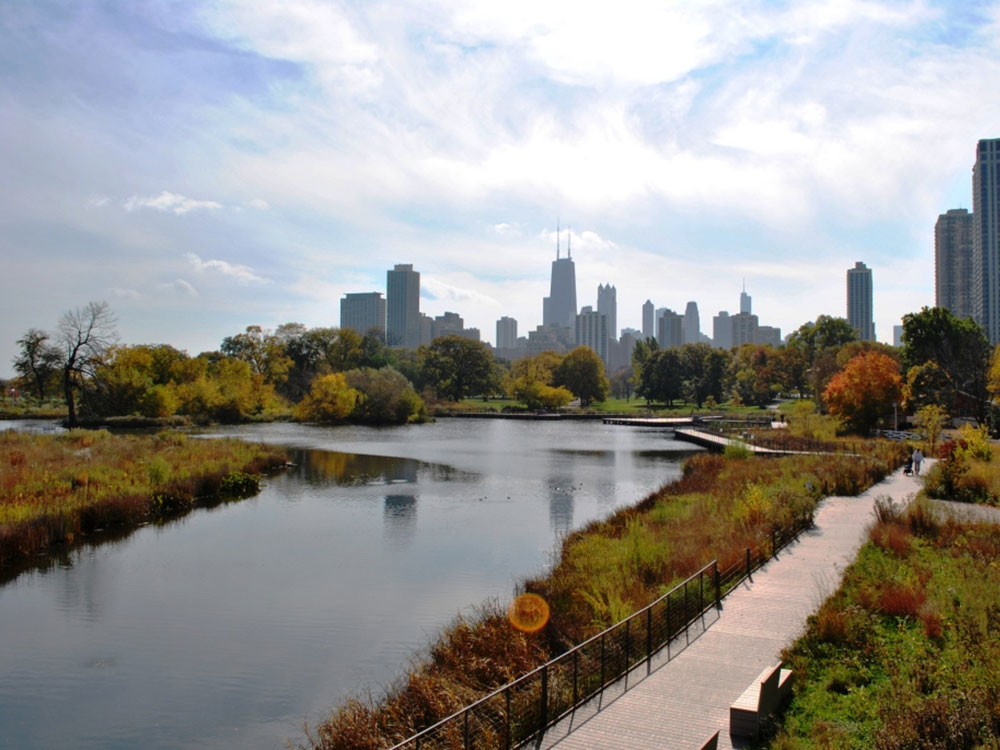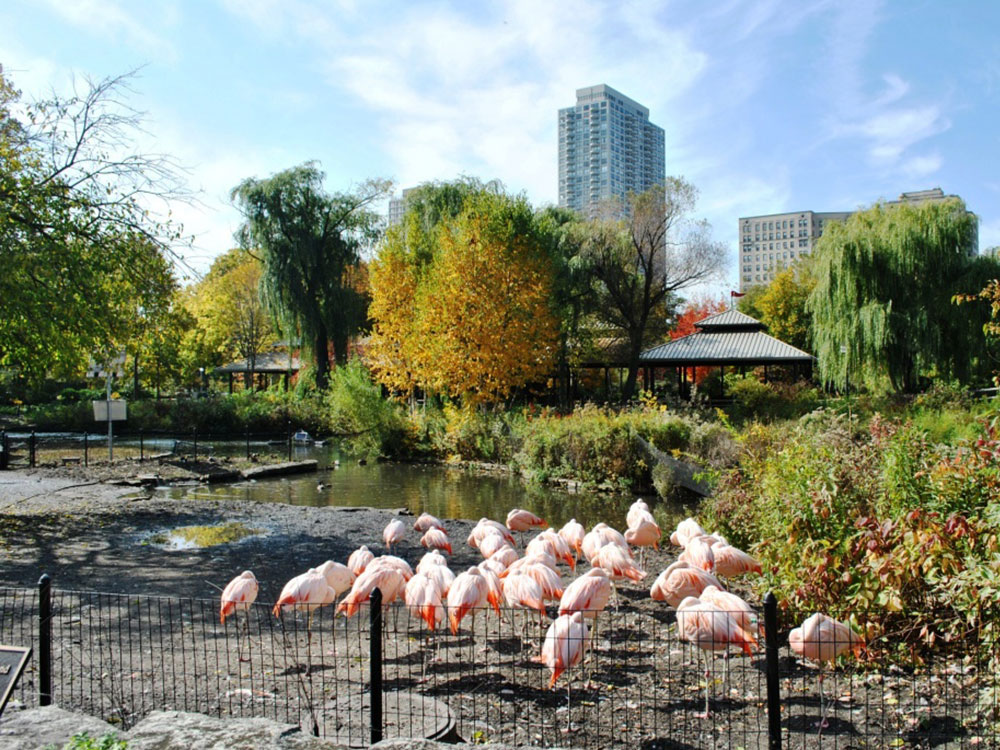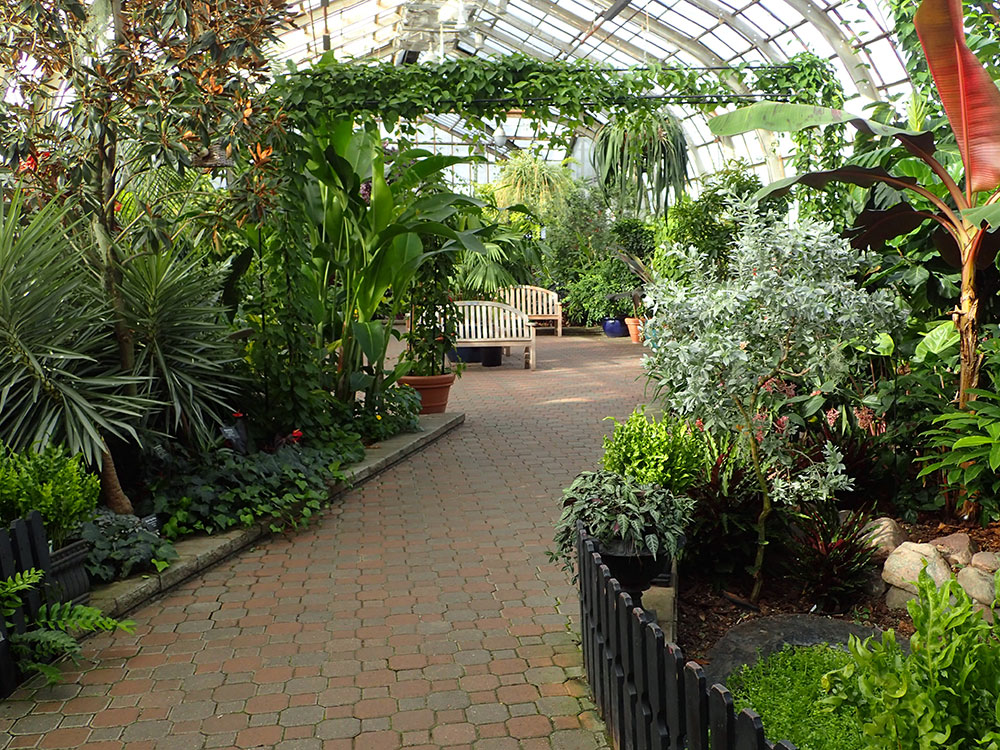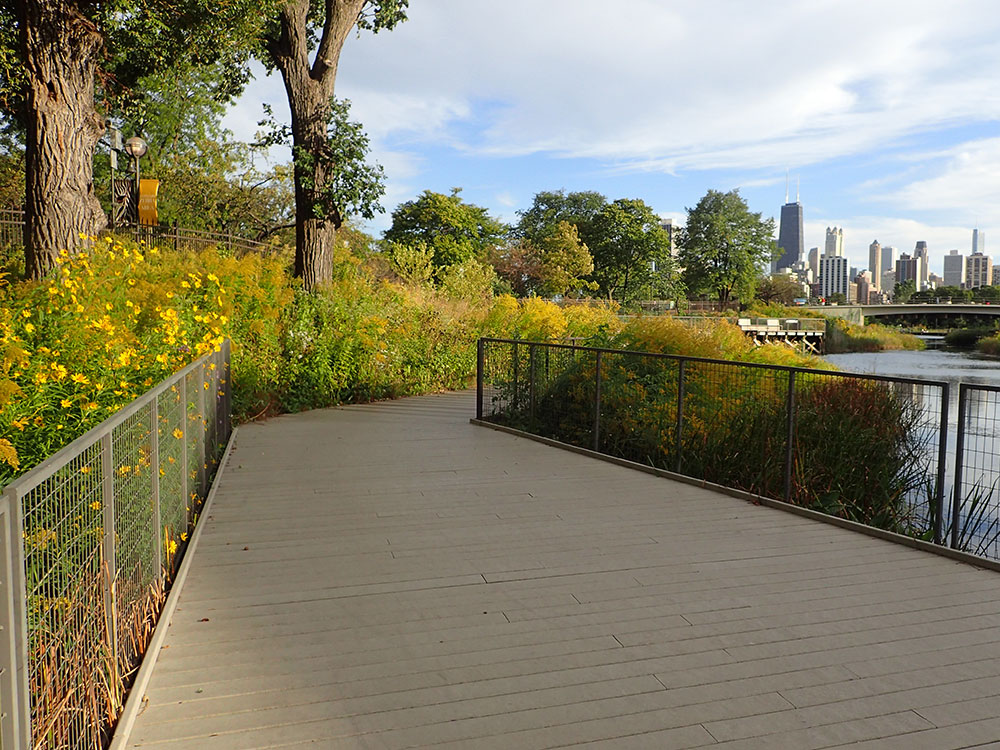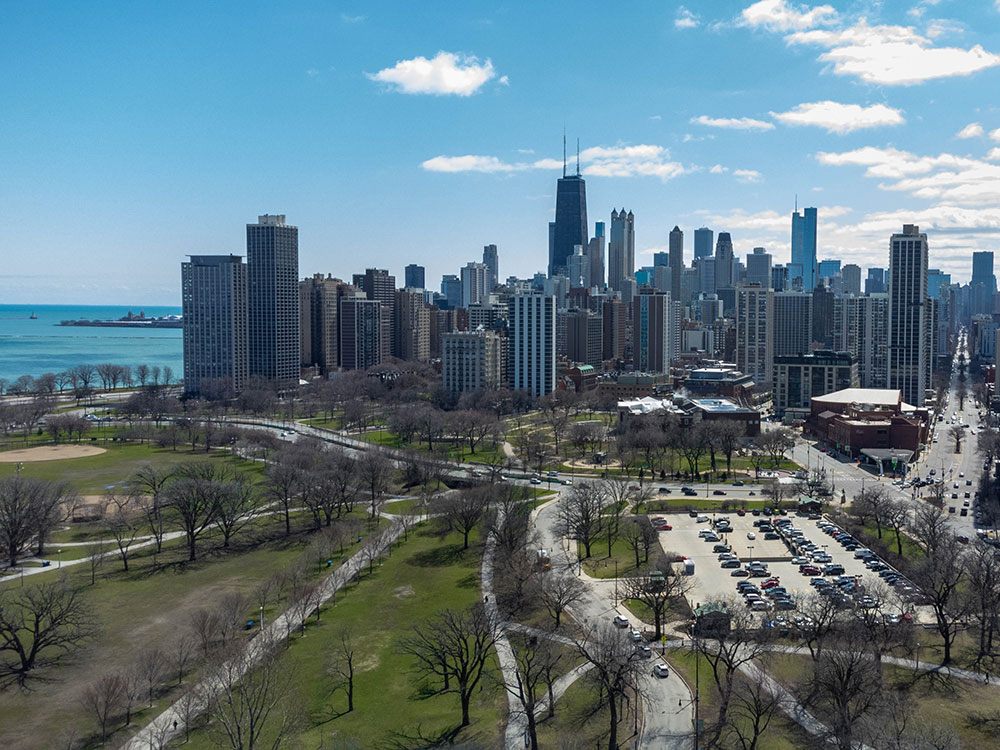1,208-acre park situated along Lake Michigan on the North Side of Chicago, is the second-most-visited city park in the United States, behind Central Park
General Information
How to Get There
Overview
Lincoln Park is a 1,208-acre (489-hectare) park situated along Lake Michigan on the North Side of Chicago, Illinois. Named after US President Abraham Lincoln, it is the city's largest public park and stretches for seven miles (11 km) from Grand Avenue (500 N) on the south to near Ardmore Avenue (5800 N) on the north, just north of the Lake Shore Drive terminus at Hollywood Avenue. Several museums and a zoo are located between North Avenue (1600 N) and Diversey Parkway (2800 N). Further to the north, the park is characterized by parkland, beaches, recreational areas, nature reserves, and harbors. To the south, there is a more narrow strip of beaches east of Lake Shore Drive, almost to downtown. With 20 million visitors per year, Lincoln Park is the second-most-visited city park in the United States, behind Central Park.
The park also features several harbors with boating facilities, as well as public beaches for swimming. There are landscaped gardens, public art, bird refuges, a zoo, the Lincoln Park Conservatory, the Chicago History Museum, the Peggy Notebaert Nature Museum, the Alfred Caldwell Lily Pool, and a theater on the lake with regular outdoor performances held during the summer.
Lincoln Park is well known for the Lincoln Park Zoo, a free zoo that is open year-round. Lincoln Park Zoo is home to a wide variety of animals. It includes big cats, penguins, gorillas, reptiles, monkeys, and other species totaling to nearly 1,250 animals. Two sections of Lincoln Park Zoo have been set aside for children. The partially indoor Pritzker Family Children's Zoo includes habitats of various North American wildlife. The Farm-in-the-Zoo is a working reproduction of a Midwestern farm containing horses and livestock such as pigs, cows, and sheep. At the Farm-in-the-Zoo, children can feed and interact with the animals and view live demonstrations of farm work such as the milking of cows. In 2010, the Zoo transformed the South Pond, to create a wildlife marsh habitat, with a Nature Boardwalk.
The Lincoln Park Conservatory offers year-round displays of plants from many different climates around the world. Today's conservatory was built in stages from 1890 to 1895. It consists of a vestibule, four display halls and fifteen propagating and growing houses. The vestibule and Palm House were built and opened to the public in 1892 and contain giant palms and rubber trees, including a 15 m (50 ft) fiddle-leaf rubber tree planted in 1891. In the Palm House, one can also find Garden Figure, a sculpture by Frederick Hibbard. The Fern Room or Fernery was opened in 1895. It contains plants of the forest floor, primarily a vast collection of ferns. The Tropical Room was originally called the stove house. Opened in 1895, it contained an assortment of tropical plants suspended from bark-covered walls. It is now called the Orchid Room and has a collection of approximately 25,000 natural species. The Display House is used for seasonal flower and plant exhibits.
Alfred Caldwell Lily Pool
Located on Fullerton Parkway between Stockton and Cannon Drives, the Alfred Caldwell Lily Pool is an historic example of Prairie School landscape architecture. The Lily Pool was listed on the National Register of Historic Places and as a National Historic Landmark on February 17, 2006. The Lily Pool had originally been built to cultivate tropical water lilies in 1889. In the 1930s, the Works Progress Administration hired landscape architect Alfred Caldwell to redesign the pool in the Prairie School style. From 1998 to 2002, the Lily Pool underwent an extensive restoration by the Lincoln Park Conservancy and the Chicago Park District, which earned the site its historic designations, and renamed the site after Alfred Caldwell.
First established in 1857, the Chicago Academy of Sciences opened its most recent facility, the Nature Museum, in 1999. The Academy's previous museum building, the Matthew Laflin Memorial Building, was the Park District's first museum in the parks. The museum's exhibits include displays about the ecological history of the Illinois region, a live butterfly house, and a green home demonstration. The butterfly house features over 200 species of exotic butterflies. The museum also offers educational programs for adults and children.
Located at Clark Street and North Avenue, the Chicago History Museum (formerly the Chicago Historical Society) is dedicated to Chicago's human history. Perhaps among its most well-known possessions are Abraham Lincoln's deathbed and several furniture pieces from the room where he died in the Petersen House in Washington, D.C., as well as clothing he and wife Mary Todd Lincoln wore the evening of his assassination. The museum also houses Chicago's most important collection of materials related to local history from the Great Chicago Fire to the Young Lords in Lincoln Park. In addition to the exhibits, the museum continues to house an extensive research library which includes books and other published materials, manuscripts, paintings, sculptures, and photos.
There are seven public beaches along the park's 7-mile shoreline. The beaches from north to south are, Thorndale, Hollywood, and Foster in Edgewater; Montrose in Uptown; North Avenue in Lincoln Park; and Oak Street and Ohio in Near North. The first City of Chicago public beach, North Avenue Beach, opened in Lincoln Park in 1895.
The Chicago Lakefront Trail (abbreviated as LFT) is an 18-mile multi-use path in Chicago along the coast of Lake Michigan. It is popular with cyclists and joggers. From north to south, it runs through Lincoln Park, Grant Park, Burnham Park and Jackson Park.
Abraham Lincoln: The Man is a famous standing Lincoln statue in Lincoln Park by Augustus Saint-Gaudens, the same sculptor who created Abraham Lincoln: The Head of State in Grant Park. Replicas of Lincoln Park's Standing Lincoln can be found at Lincoln's tomb, Springfield and in Parliament Square, London. The statue is located at Dearborn Street and North Avenue. It was fully restored in 1989 by the Lincoln Park Conservancy's Adopt-A-Monument Program, and 8,200 square feet of formal gardens were added in front of the monument.
The only other person memorialized in statue in both Grant and Lincoln parks is Alexander Hamilton; the statue of Hamilton was sculpted by John Angel. There is also a large memorial to Ulysses S. Grant in Lincoln Park overlooking Cannon Drive. The sculpture was created in 1891 by Louis Rebisso.
The statue of Hans Christian Andersen by Johannes Gelert (1896) on Stockton Drive near Webster Avenue provides a tribute to the Danish storyteller. The Eugene Field Memorial (1922) designed by Edward McCartan remembers the Chicago Daily News columnist and poet who wrote "Little Boy Blue" and "Winken, Blinken, and Nod." William Ordway Partridge's statue of William Shakespeare (1894) provides a third great story-teller in Lincoln Park. This seated Shakespeare includes a lap for children to climb onto. A bust of Sir Georg Solti, a conductor of the Chicago Symphony Orchestra, was also situated in the Lincoln Park Conservatory's formal garden until its relocation to Grant Park in 2006. Statues honoring the German poets Johann Wolfgang von Goethe and Friedrich Schiller can also be found in Lincoln Park. The large Goethe statue is located near Diversey Parkway and Stockton Drive. The smaller Schiller statue is located near the western entrance to the zoo. Cyrus Edwin Dallin's 1890 A Signal of Peace is exhibited at the park.
At Addison Street stands a 40-foot (12-meter) totem pole depicting Kwanusila the Thunderbird. A statue of John Peter Altgeld (1915), the nineteenth-century Illinois Governor who pardoned the men convicted in the Haymarket affair bombing, can be seen just south of Diversey. This statue was created by Gutzon Borglum and unveiled on September 6 (Labor Day), 1915. Borglum went on to create the Mount Rushmore National Memorial.
This article uses material from the Wikipedia article "Chicago History Museum", which is released under the Creative Commons Attribution-Share-Alike License 3.0
Featured Locations
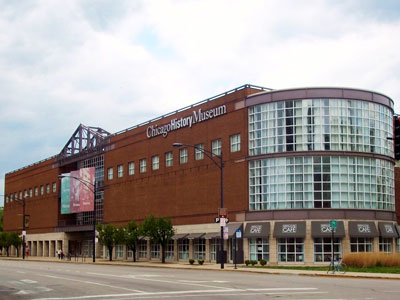
Alanscottwalker, CC BY-SA 3.0, via Wikimedia Commons; Image Size Adjusted
Chicago History Museum
RatingMuseum of the Chicago Historical Society (CHS), founded in 1856 to study and interpret Chicago's history
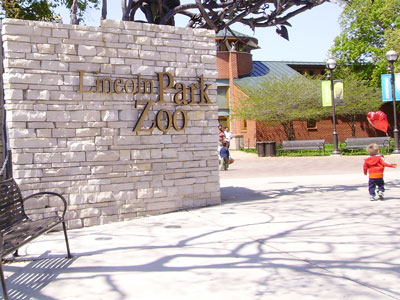
chascarper from Chicago, U.S.A., CC BY 2.0, via Wikimedia Commons; Image Size Adjusted
Lincoln Park Zoo
Rating35-acre zoo in Lincoln Park was founded in 1868, making it the fourth oldest zoo in North America
